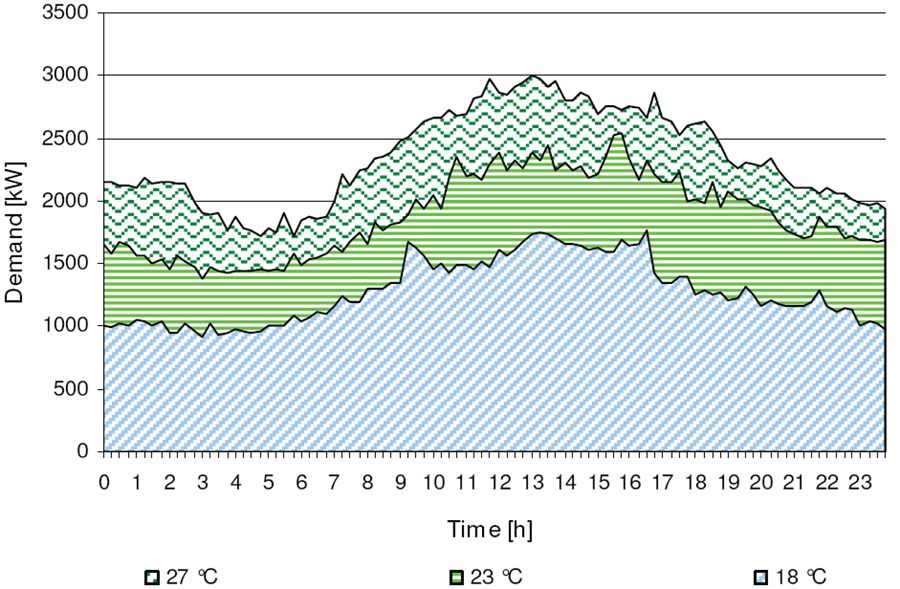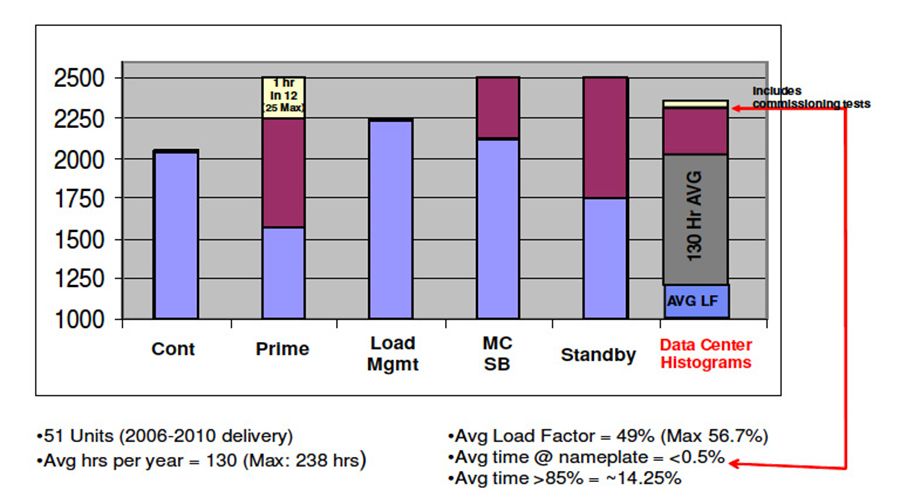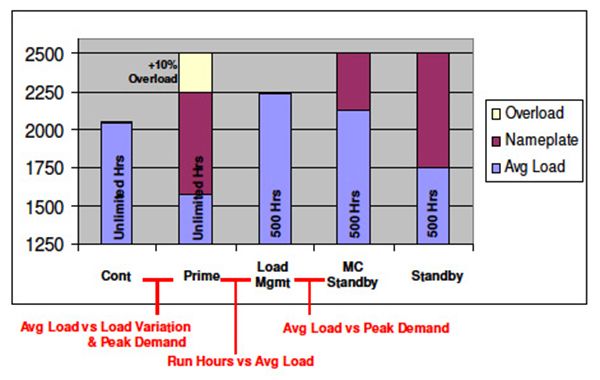Data centers are often designed and specified around a constant load and worst possible ambient conditions. This does not reflect real-world operation and will result in excess equipment being specified. For a data center, a large portion of the load is supported by UPS systems. As UPS systems recharge, additional power (typically 5 to 10 percent over a matter of minutes) is drawn to recharge the energy storage system. Once the energy storage system has been recharged, this power draw is no longer required. Further, the total required power will fluctuate, even if slightly, with natural ambient changes. As these ambient changes move away from the maximum ambient design, they will affect engine performance in a positive manner.
Thus, in a severe, long-term outage throughout a given day, week or month, regardless of site, the ambient will fluctuate below the system’s maximum design ambient. Along with load changes, this fluctuation should be accounted for when looking at load engine/genset performance and capability. Doing so will maximize the value received from the generator set. Another consideration of the “100 percent load for 100 percent of operating hours” is the customer’s understanding of the actual operation and its affect on product maintenance and life overhaul. Theoretical “unlimited” runs with any nameplate rating are unfeasible due to product maintenance requirements. Recommended oil change schedules vary by site and application, but for a product operating in higher hour applications, they tend to follow a 500-hour interval (or annually) schedule. Operating a generator outside of the rating guidelines will decrease the time between these oil changes. Provisions during the design phase and an understanding of actual operating conditions should account for this and other maintenance requirements. In short, having an established site-specific plan to respond to a long-term outage is much more important than a generator’s nameplate rating.
If the user truly desires an unlimited number of run hours, then a Standby-rated generator set is certainly not the appropriate choice. However, as demonstrated in Figure 2, which illustrates actual operating data, most of the “realworld” Standby operational equipment fits into the Standby rating just fine. This data shows real-world operation from a sample set of 2.5 MW-rated generator sets at data center sites. Included in the data is high-load, high-hour commission tests at virtually all sites. The real-world load profiles for all of these data centers fit well into any of the applications including Standby.
For users concerned with pushing average load factor limits, the load management rating may be a better solution for them. The data presented in this table is not intended to tell the users how they should design projects or operate equipment. However, this data serves as a real-world example using data demonstrating that the traditional Standby (ISO) rating serves real-world applications nicely.
Components in an integrated electric power system are also impacted by loading. For example, UPS loading has an impact on generator requirements. When generator sets are under loaded, so too are the associated UPS products. These under-loaded UPS products increase the harmonic content, requiring a larger generator set end, which in turn can result in increased system cost. This is yet another example of how right-sizing the entire system and selecting a vendor partner who can speak to all of these tradeoffs can provide significant cost and design benefits.
RATINGS REFINED
Ratings are typically defined in terms of maximum power available, average load factors, hours of usage per year, peak demand and typical applications. These broad definitions are intended to cover a wide range of industrial and commercial uses. Because of this variability, some manufacturers, including Caterpillar, have chosen to adopt the standard definitions in their most conservative form to minimize the risk of equipment misapplication.
Many generator set manufacturers have different names or variations for their ratings, so it is important to know how those ratings compare to the ISO standards. For example, Caterpillar defines five basic generator set ratings: Emergency Standby Power (ESP), Standby (no ISO equivalent), Mission Critical Standby (no ISO equivalent), Continuous and Prime. Cat® generator set ratings differ in certain respects from those defined by ISO 8528-1, but will always meet the minimum criteria set forth by the standard. ISO-8528 identifies four ratings:
- Continuous power
- Prime power
- Limited running (LTP)
- Emergency standby power
Continuous Power (COP) In this application, the generator set is able to provide power to a nonvarying load for an unlimited number of hours per year. The average power output of the generator set is 70-100 percent of the rating. The rating is designed to provide 100 percent of the rating for 100 percent of the operating hours.
Typical Continuous rating applications include base loading in parallel with a utility and cogeneration operations.
An important thing to note in this definition is the relatively “steady load” requirement of a Continuous application. One should ensure that significant amount of load fluctuation does not exist, as the Prime rating can provide a better fit and higher peak output for those that do.
Prime Power (PRP) A Prime-rated generator set is capable of providing power to a varying load for an unlimited number of hours per year. A Prime-rated generator set is capable of providing full nameplate rating for a period of time, but it must have an average load factor of no more than 70 percent of the Prime rating. Ten percent overload is allowed for emergencies at a maximum of one in 12 hours and no more than 25 hours per year. The Prime rating can be used in either utility paralleling or isolated applications.
With this rating, one should note the offering of a more varying load but the inclusion of an average load factor – it’s not 100 percent like the continuous rating. While it may seem better to offer the 100 percent load factor continuous rating, if a certain amount of load fluctuation exists, the Prime rating can provide superior value.
Some manufacturers will once again vary slightly from this ISO standard in order to provide a perceived benefit. While these are usually superficial differences from one manufacturer simply stating the ISO standard, there can also be differences and tradeoffs in overload capability from one manufacturer’s rating to the next.
The Limited-Time Power (LTP) A Prime-rated generator applied under Limited-Time Power guidelines allows for a Prime-rated generator set to be used in parallel with the utility. A Prime-rated generator set under Limited-Time Power guidelines can run for a maximum of 500 hours per year. This generator set has the same nameplate rating as a Prime-rated unit but allows for an average load factor of up to 100 percent. The Limited-Time Power guidelines do not allow for a 10 percent overload capability.
The equivalent rating for Cat® generator sets is a Load Management rating. This rating provides a middle ground for those wanting the load factor performance of a Continuous product (100 percent of prime rating) and the nameplate capability of a Prime product for only a small period of time (anticipated to be less than 500 hours) each year.
Figure 3 illustrates the nameplate (top of each bar) versus the average load factor (blue) along with any hour limitations listed for each rating. The content in red demonstrates the trade-offs between the various ratings.
In this example, we’re looking at the trade-offs for a 2.5 MW generator set at Standby rating. If this engine were run in a load management application, the operator would be trading the number of hours run for the average load capacity.
Emergency Standby Power (ESP) The ESP rating allows a maximum running time of 200 hours per year at a 70 percent average load factor.
Under this rating, the permissible average power output over a 24-hour period of operation should not exceed 70 percent of the ESP unless otherwise agreed by the engine manufacturer. ESP is different from traditional Standby power, which is not defined by ISO, yet some manufacturers will represent these two ratings as the same. While this allows for more liberal product design, it could have a negative long-term affect on owning and operating costs if an ESP-rated generator set is run in a traditional standby application.
Emergency Standby Power generators are rated to run at 70 percent output, with varying loads, for a short period of time – generally 50 to 200 hours per year. Standby Power offers the same output and load characteristics but is allowed to run up to 500 hours annually at the Standby rating considerations.
Two additional ratings include:
Mission Critical Standby is a new and formally approved rating from Caterpillar. It allows for higher average load factor, which has become a market requirement (especially in data centers). It also ensures the user is monitoring the time at nameplate to maximize service intervals and minimize cost. This rating matches competitors with a published 85 percent load factor, which also limit time at nameplate to 5 percent. Once again, no engine iron changes have been made, illustrating another difference in performance allowances.
Standby Power In this application, the generator set is capable of providing emergency backup power at the nameplate rating for the duration of an outage. The average load factor of a Standby-rated generator set should be no more than 70 percent of the nameplate rating and applied to varying loads. A Standby generator set can run for a maximum of 500 hours per year. The normal standby rating is not for use in utility paralleling applications, but rather it is intended for naturally varying loads, which given the natural variability, allows Caterpillar to state that power is available for the duration of an outage.
WHY RATINGS MATTER
When evaluating a generator set, ratings are important because they directly impact the efficiency and effectiveness of the selected generator set based on how it’s going to be used. An engine that is aggressively rated could result in accelerated wear and unplanned downtime, while an overly conservative use of ratings does not provide optimum value.
It is especially important to understand the specific application in detail, as this will help in selecting the proper rating. Specifically, the following factors should be taken into consideration:
- What is the average load factor?
- What is the maximum required load?
- What is the typical load variation?
- How many hours per year will the generator sets typically run?
- Will the generator sets be run isolated from or in parallel with the utility?
- What are my maintenance and contingency plans during an extended outage?
Knowing the specifics of the application is important because in many circumstances, as explained previously, the same engine iron can qualify for different ratings. This can sometimes cause confusion with certain project specifications, which may call for multiple ratings. For example, a spec sheet could say: “Generator shall be rated 2 MW Standby, 1825 kW Prime.” In this case, the engine iron is the same, but the same product cannot be applied in both application types. This statement is misleading, because the ratings should state specifically what the intended application of the equipment is – is it Standby or Prime?
CONCLUSION
Generator set rating guidelines are based on a collection of design limits that are used to ensure that the equipment will meet the required reliability and durability goals under a wide range of applications. There is an infinite number of possible ratings. If the scope of use were to be more narrowly defined and the range of conditions more tightly controlled, application-specific ratings could be developed that would enable operation of the equipment closer to its full capabilities with minimal impact on thermal, structural or wear factors, and risk of downtime. A handful of published ratings are simply ISO and the manufacturers’ efforts to capture the vast majority of the market’s operational requirements. Caterpillar offers a portfolio of generator set ratings designed to provide coverage from general to special-purpose applications to maximize owner value.
Regardless of the application, generator set ratings help to ensure that customers’ power needs are met and that generating equipment is protected from premature wear. Choosing the right rating means making the proper trade-offs between run hours, peak load and average load. It also means receiving the optimum combination of installed cost and long-term cost of ownership.
REFERENCES
- ISO Standard 8528-1 (2005), Reciprocating Internal Combustion Engine Drive Alternating Current, Generating Sets
- Publication LEXE0047, Understanding Generator Set Ratings









